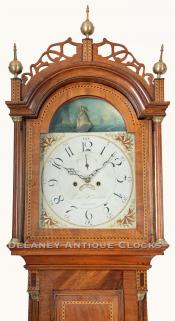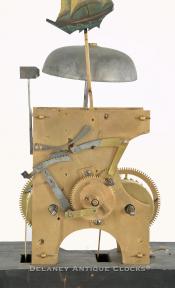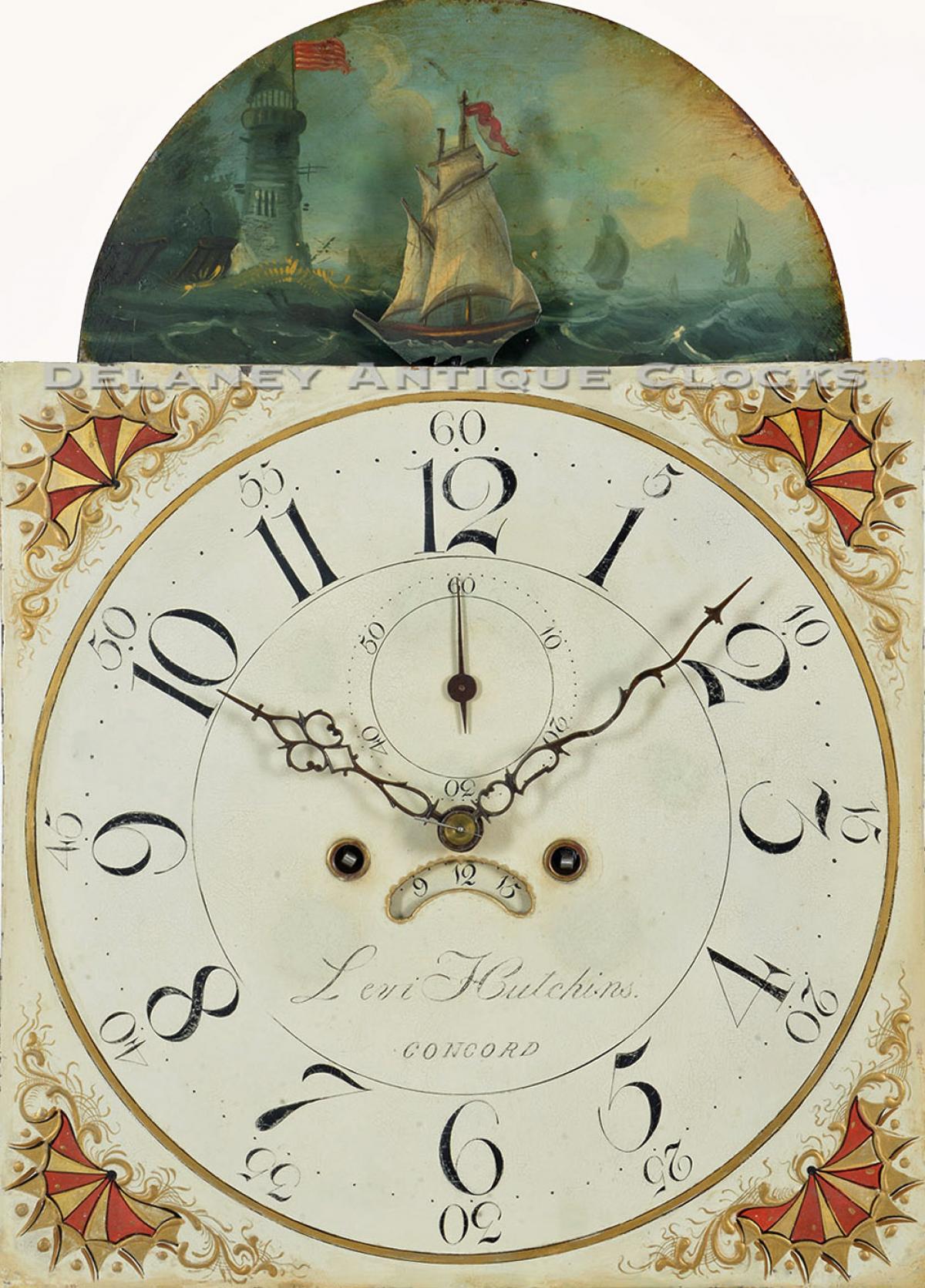Levi Hutchins of Concord, New Hampshire. A high-style inlaid mahogany case tall clock. The best that colonial New Hampshire had to offer. It also features a rocking ship dial. ZZ-2.
Levi Hutchins of Concord, New Hampshire, made this high-style inlaid mahogany-cased tall clock. Levi is best known in the horological world as being half of a clockmaking partnership that included his younger brother Abel Hutchins. A small number of clocks that retain Levi's signature are known. Most of the Hutchins-made clocks that surface in the marketplace seemed to be signed by the partnership or solely by his brother Abel.
This is a beautiful and complex example. The case features Boston proportions and form. The cabinet is constructed in various kinds of wood, including mahogany, mahogany veneers, curly maple, bird's-eye maple, rosewood, and white pine. The case stands on nicely formed flared French. These retain excellent height and are applied and transition smoothly up into the base panel. Please note the drop apron in the front. The feet are visually separated from the base by a line inlay pattern that frames the four sides of the base panel. Stepping in from this detail is a broad section of figured mahogany used as a cross-banded border. A second complex line pattern frames the center section of figured mahogany. A shaped waist molding transitions the base to the waist. A rectangular-shaped waist door provides access to the clock's original tin can weights and brass-faced pendulum. This door is veneered with a selection of crotch mahogany. The panel is framed with a complex band of inlay. The front corners of the waist are fitted with reeded quarter columns. These terminate in brass quarter capitals at each end. The capitals are mounted on inlaid blocks, top and bottom. The bonnet is surmounted with a New England style pierced and open fretwork decoration, three capped finial plinths inlaid with a complex design, and three brass ball and spiked finials. The bonnet columns are reeded and are supported by brass capitals. These flank the arched door. The prevailing inlay pattern is repeated in this location. This door opens to allow one access to the painted iron dial.
This iron dial is of Boston origin and was manufactured and painted by one of the Nolen dial firms. It features very colorful fans in each of the four spandrel areas. These are surrounded by raised gesso decorations that are highlighted in gilt paint. The automated feature of a rocking ship is located in the arch of this dial. The painted ship is depicted flying a red flag. This ship moves or rocks gently from side to side with the pendulum's motion. The painted scene behind the sailing ship includes a large lighthouse built out on a peninsula located on the left. This nautical theme is painted on a convex piece of metal and adds to the visual depth to the scene. Below the calendar aperture, the Clockmaker boldly signs this dial-in script lettering. The signature reads, "Levi Hutchins." The working location of "CONCORD" is inscribed in block lettering below. The time ring features Arabic-style hour numerals. A minute track separates these from the smaller Arabic five-minute markers. A subsidiary seconds dial and calendar display are both located in the traditional locations. Decorative steel hands display the time.
The movement is constructed in brass and is weight-driven. It is designed to run eight days on a full wind and strike each hour on a cast iron bell. The cast iron bell is mounted above the movement on a stand. This movement is of good quality.
This clock stands approximately 8 feet 3.5 inches tall to the top of the center brass finial. It is 21.5 inches wide and 10.25 inches deep. This clock was made circa 1810.
A closely related example is now on display at the Currier Museum of Art in Manchester, New Hampshire.
Inventory number ZZ-2.
Levi Hutchins was born in Harvard, Massachusetts, on August 17, 1761, and died peacefully on June 13, 1855. He was 93. His remains were interned in the Friends' burial ground in Concord, New Hampshire. Interestingly, this was a society he somewhat withdrew from several years before his death. Levi was one of eleven children. His parents were Colonel Gordon Hutchins & Dolly or Dorothy Stone. Levi had a younger brother named Abel, born in March of 1763. He also became a clockmaker and, for a time, worked with his brother in a partnership. Able died in the town of Concord on April 4, 1853. Both men lived into their nineties and lived long, prosperous lives. I have listed some of Levi's life's highlights below.
In 1772, their father moved the family from the town of Harvard, MA, to Concord, NH. In Concord, he purchased land and buildings and commenced as a storekeeper. Gordon became active in the revolution and served as a Captain in the local regiment. Young Levi served in his regiment as a Fifer from April to September 1775. In May of that year, Gordon Hutchins marched to Breeds Hill under the command of Colonel John Stark. Young Levi accompanied them and watched the battle from a distance high on the hills of Medford, MA. Levi also witnessed the burning of Charlestown. His father, Gordon, was later stationed at Winter Hill until the end of that year. Levi enlisted in Captain Lewis' Company, in Colonel Varnum's Regiment, under General Green. In the spring of 1776, he marched to New York under the orders of General Washington to protect the city. He was posted in Brooklyn for a while. He remained posted on the island of Red Hook, which is located 4 miles from New York and is situated to protect the harbor until the defeat of the Americans in the battle of Long Island. Levi was honorably discharged and returned to New Hampshire on horseback.
Levi was well educated. He attended Byfield Academy for one year and Andover Academy for two quarters. He was then recruited as a school teacher and taught in Tewksbury, Pembroke, and Ashburnham, Massachusetts.
On December 6, 1777, the two brothers entered into an apprenticeship with the ingenious Grafton, Massachusetts clockmaker, Simon Willard. At this time, Levi was sixteen, and Abel was fourteen years of age. After Levi served his 3-year indenture to Simon, he traveled to Abington, CT, to serve an eight-month apprenticeship in the watch repair trade.
Levi may have moved to Concord, New Hampshire, as early as 1782. Here he set up a residence and shop on Main Street in the central village. His first shop was very near the railroad passenger depot, not far from the junction of the Merrimack River and the roads from Boston, Portsmouth, and the Connecticut Valley. Soon after Levi arrived, his brother Able moved up from Roxbury, MA, having worked with the Willards for a few years. Together they formed a partnership that lasted until about 1803 and became the most prolific clockmakers in the Concord region for a number of years. Based on the number of examples that trade in the marketplace, their output of tall case clocks was substantial. The earliest known advertisement helps date their partnership. It was published in 1788 in the New Hampshire Spy. They placed an ad in the Concord Herald in 1790 and again in 1792, looking for two apprentices. It is thought that Peabody Atkinson and Jesse Smith answered the ad and trained under them. Both men are recorded as working as farmers in Virginia in their later years.
On February 23, 1789, Levi married Phoebe Hanaford, daughter of Benjamin, and Ruth Hanaford of Haverhill, MA. Together they had ten children. Levi made each one of them a clock before he passed.
In 1793, Levi and Abel purchased a farm three miles away on the western side of Rattlesnake Hill. Here they continued to manufacture clocks and also began to farm.
In 1807, their partnership was dissolved. Abel bought out Levi's share of the business and paid off all debts. Levi received the farm and opened his own shop opposite Gale's Tavern. Abel retained the house and original shop, and the parcel of land. On Tuesday, November 25, 1817, these buildings were consumed by fire. Two years later, Abel erected the Phoenix Hotel.
In 1808, Levi purchased a house on 70 acres, including an apple orchard, a dilapidated fort, a large barn, a woodshed, and later a sawmill located on Long Pond in the West Parish or West Concord Village.
After the War of 1812, in about 1815, Levi built a large building and set up five looms to manufacture cloth. The cloth business lasted three years before it became unprofitable and sold off. One room in this barn was used for clockmaking. Levi continued to work on brass clocks for 20 years. The sawmill operated for 50 years.








